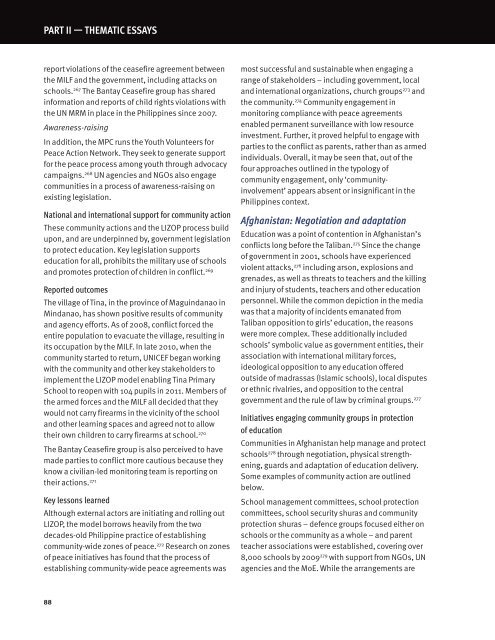Create successful ePaper yourself
Turn your PDF publications into a flip-book with our unique Google optimized e-Paper software.
PART II — THeMATIC eSSAYSreport violations of the ceasefire agreement betweenthe MILF and the government, including attacks onschools. 267 The Bantay Ceasefire group has sharedinformation and reports of child rights violations withthe UN MRM in place in the Philippines since 2007.Awareness-raisingIn addition, the MPC runs the Youth Volunteers forPeace Action Network. They seek to generate supportfor the peace process among youth through advocacycampaigns. 268 UN agencies and NGOs also engagecommunities in a process of awareness-raising onexisting legislation.National and international support for community actionThese community actions and the LIZOP process buildupon, and are underpinned by, government legislationto protect education. Key legislation supportseducation for all, prohibits the military use of schoolsand promotes protection of children in conflict. 269Reported outcomesThe village of Tina, in the province of Maguindanao inMindanao, has shown positive results of communityand agency efforts. As of 2008, conflict forced theentire population to evacuate the village, resulting inits occupation by the MILF. In late 2010, when thecommunity started to return, UNICEF began workingwith the community and other key stakeholders toimplement the LIZOP model enabling Tina PrimarySchool to reopen with 104 pupils in 2011. Members ofthe armed forces and the MILF all decided that theywould not carry firearms in the vicinity of the schooland other learning spaces and agreed not to allowtheir own children to carry firearms at school. 270The Bantay Ceasefire group is also perceived to havemade parties to conflict more cautious because theyknow a civilian-led monitoring team is reporting ontheir actions. 271Key lessons learnedAlthough external actors are initiating and rolling outLIZOP, the model borrows heavily from the twodecades-old Philippine practice of establishingcommunity-wide zones of peace. 272 Research on zonesof peace initiatives has found that the process ofestablishing community-wide peace agreements wasmost successful and sustainable when engaging arange of stakeholders – including government, localand international organizations, church groups 273 andthe community. 274 Community engagement inmonitoring compliance with peace agreementsenabled permanent surveillance with low resourceinvestment. Further, it proved helpful to engage withparties to the conflict as parents, rather than as armedindividuals. Overall, it may be seen that, out of thefour approaches outlined in the typology ofcommunity engagement, only ‘communityinvolvement’appears absent or insignificant in thePhilippines context.Afghanistan: Negotiation and adaptationEducation was a point of contention in Afghanistan’sconflicts long before the Taliban. 275 Since the changeof government in 2001, schools have experiencedviolent attacks, 276 including arson, explosions andgrenades, as well as threats to teachers and the killingand injury of students, teachers and other educationpersonnel. While the common depiction in the mediawas that a majority of incidents emanated fromTaliban opposition to girls’ education, the reasonswere more complex. These additionally includedschools’ symbolic value as government entities, theirassociation with international military forces,ideological opposition to any education offeredoutside of madrassas (Islamic schools), local disputesor ethnic rivalries, and opposition to the centralgovernment and the rule of law by criminal groups. 277Initiatives engaging community groups in protectionof educationCommunities in Afghanistan help manage and protectschools 278 through negotiation, physical strengthening,guards and adaptation of education delivery.Some examples of community action are outlinedbelow.School management committees, school protectioncommittees, school security shuras and communityprotection shuras – defence groups focused either onschools or the community as a whole – and parentteacher associations were established, covering over8,000 schools by 2009 279 with support from NGOs, UNagencies and the MoE. While the arrangements are88


